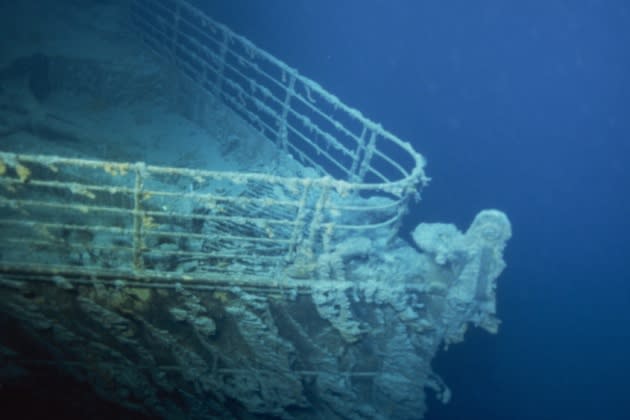Titanic Tourist Submarine: Debris Field Found on Sea Floor Near Shipwreck

UPDATE (June 22): A debris field has been found in the search area around the Titanic shipwreck, the U.S. Coast Guard confirmed on Thursday.
The debris was discovered by a remote-operated vehicle (ROV) commandeered by the Horizon Arctic. The U.S. Coast Guard has scheduled a press briefing at 3 p.m. EST to provide a full update on the findings and what they may signal about the fate of the Titan submersible.
More from Variety
The frantic search for the vessel, which went missing on Sunday almost two hours into its dive to see the Titanic, reached mission critical on Thursday as the five crew members reached the final hours of their estimated air supply overnight.
The search area for the truck-sized vessel is now 10,000 square miles of ocean but rescue teams are still struggling to locate the sub. Noises picked up on Tuesday and Wednesday in regular intervals provided some hope that the crew may be trying to communicate; however, that discovery has yet to lead to a precise location. On Thursday morning, the BBC reported that 10 extra ships and a number of remote submarines are joining the operation, which will effectively double the search effort.
The vessel has a 96-hour air supply that, in theory, ran out around 12 p.m. U.K. time on Thursday, although a captain involved in the operation said that wasn’t “a hard and fast number.”
Elsewhere, Paramount Global-owned U.K. broadcaster Channel 5 revealed plans to air a fast-turnaround documentary on the search for the Titan. The ITN-produced “Titanic Sub: Lost at Sea” will air on Thursday evening U.K. time.
UPDATE (June 21): Banging sounds have been detected in a search area for the missing Titanic tourist submersible. Following reports in CNN and Rolling Stone that cited internal U.S. government memos, the U.S. Coast Guard confirmed that a Canadian aircraft has detected “underwater noises.” This marks the first breakthrough in what’s now been a three-day search and rescue operation for the truck-sized submersible that lost contact on Sunday about an hour and 45 minutes into its dive to see the Titanic wreck. The Titan’s air supply is projected to run out in less than 24 hours, as per the BBC. There are five people confirmed on board.
UPDATE (June 20): The U.S. Coast Guard shared an update on search efforts on Tuesday, telling “Good Morning America” that surface-level searches via plane took place on Monday night. Underwater searches will soon be underway using a commercial pipe-laying vessel with remote-operated vehicles. Canadian aircrafts with sonar technology have also joined the operation, alongside a deep-sea robot from France. The search has now expanded into deeper waters.
On Tuesday, the crew onboard were named. They include British businessman Hamish Harding; British-Pakistani businessman Shahzada Dawood and his 19-year-old son Suleman; former French Navy diver Paul-Henry Nargeolet; and OceanGate CEO Stockton Rush.
Search teams are believed to be focusing on the surface of the ocean and the seabed; experts indicate it’s very unlikely that the vessel could be somewhere in between. The crew is bolted inside, meaning they require outside help in order to open the submersible.
EARLIER: An underwater vessel used to take tourists to the wreckage of the Titanic has gone missing, with a search and rescue operation now underway to locate the craft.
The submersible, which is roughly the size of a truck, went missing in the Atlantic Ocean on Sunday with five crew members on board. Government agencies and deep-sea specialists are assisting with the operation.
The craft is understood to be the Titan, built by Washington-based exploration company OceanGate Inc. The Titan is designed to take five people to a depth of 4,000 meters. The structure has a life support span of 96 hours (four days) for five people, according to OceanGate’s website. Each round-trip journey to the Titanic wreckage can take up to 10 hours.
The difference between a submersible and a submarine is that the former is not as powerful, and sometimes relies on another vessel that remains on the surface. The Titan, for example, used a tugboat called the Polar Prince.
The Titanic lies at around 3,800 meters in the North Atlantic seabed, off the coast of Newfoundland, Canada. The cruise ship sank in 1912 after hitting an iceberg — a story that became almost universally known thanks to James Cameron’s blockbuster 1998 movie starring Leonardo DiCaprio and Kate Winslet.
OceanGate first launched its Titan voyages in 2019. Seats on board cost up to $250,000 per head. One of its major safety features is a real-time health monitoring system, which was designed to analyze the effects of changing pressure on the vessel, and provide early warning signs of abnormalities to the pilot.
In a statement shared with the BBC, OceanGate said: “Our entire focus is on the crewmembers in the submersible and their families. We are deeply thankful for the extensive assistance we have received from several government agencies and deep sea companies in our efforts to re-establish contact with the submersible.”
Best of Variety
Sign up for Variety’s Newsletter. For the latest news, follow us on Facebook, Twitter, and Instagram.